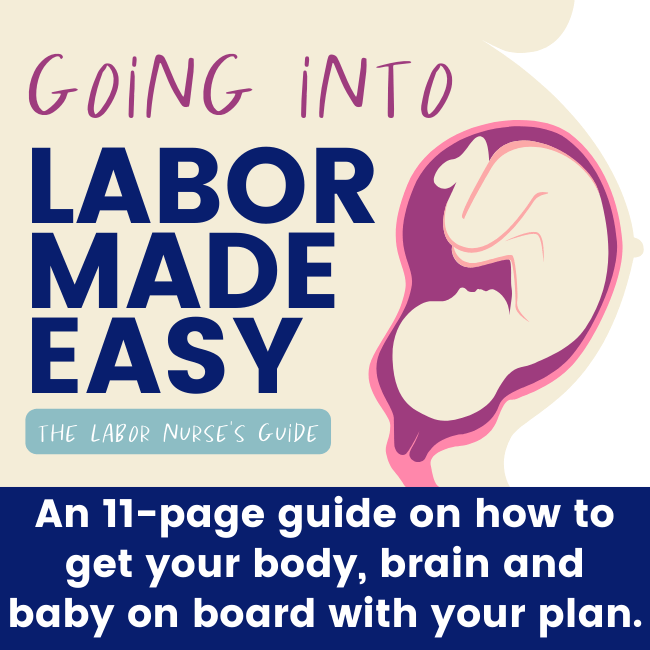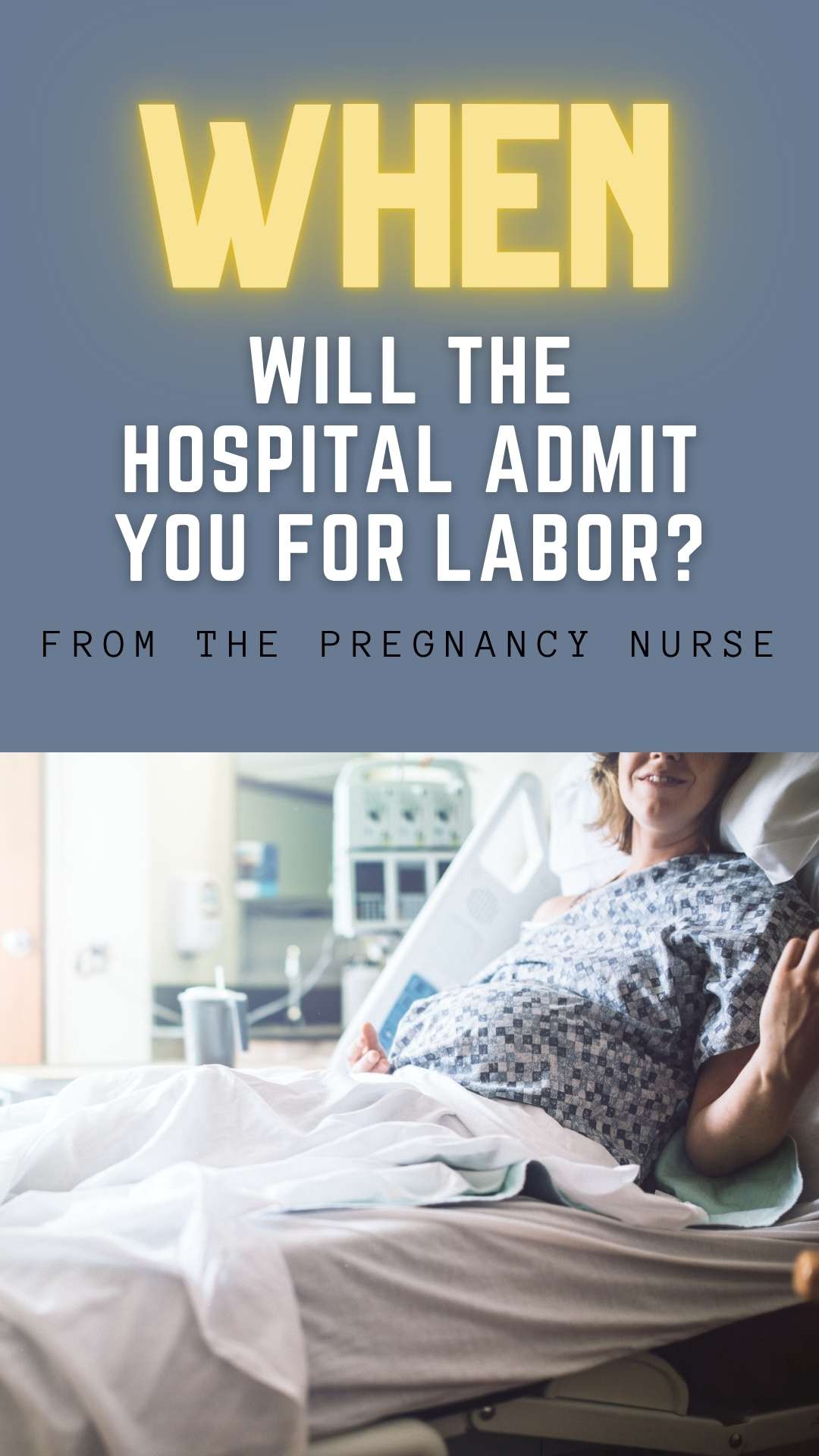📣 YOU are clearly getting prepared for pregnancy, birth & beyond — but do you wish your partner was more involved (looking for a teammate rather than just a cheerleader)? Couples love THIS! 💛🧡💚
When should you go the hospital to have your baby? Most people don’t want to go to the hospital, only to not be admitted and sent home. Today I want to talk to you about when most hospitals will “keep” you for labor and what you can do to get to that point before you go to the hospital.

But first — why should you take my thoughts on labor?
But first, how do I know all of this? Hi — I’m Hilary — The Pregnancy Nurse 👩⚕️. I have been a nurse since 1997 and I have 20 years of OB nursing experience, I am also the curly head behind Pulling Curls and The Online Prenatal Class for Couples. 🩺 I admitted thousands of patient for labor (and other things) into labor and delivery. I’ve also surveyed nurses from hospitals around the US to see what their protocols are, so I’m a pretty good place to start on this one.
As a note, this is talking about any time after 37 weeks of pregnancy — if you’re prior to that time you need to call your provider if you think you’re in labor, or are experiencing any of the signs of preterm labor. They may want to stop your contractions ( not let them keep going until you’re in active labor or you deliver your baby).
Oh, and if you’re wondering more about the hospital and what they will do you with — this is your first step. It can really be done in just a few hours and you’ll feel a lot more ready!
When Does The Hospital Admit You for Labor?
It varies depending on the hospital but for most places they want to see that you are in active labor and your cervix is actively dilating (meaning if they check you now, and then again in an hour, there is cervical change).
Yes, this means that you can walk around at 4 cm for weeks and not be admitted for labor. Although some hospitals, if they find you’re past 4 cm and uncomfortable, and past 39 weeks they may admit you and augment your labor. But, we’re going to talk about ALL of that! So, keep reading!
I also have a post all about when to go into labor and delivery that you might find helpful too!
Why People are Admitted to Labor and Delivery
People are admitted for all sorts of reasons to labor and delivery. The most common reasons:
- Preterm labor (labor before baby is ready)
- Active labor (people that are within 3-4 weeks of their due date)
- Monitor for issues with preeclampsia
- Infections (like a hard flu or kidney issues)
- Induction of labor
Honestly, the policies around when people are admitted to labor are pretty firm. BUT the most important part is a doctor’s order. The hospital can’t admit you without one of those.
How to Get Admitted to Labor And Delivery
Guys, if you are in active labor the hospital is probably the best place for you, but if you are in early labor (or are just in pain, not actual labor) it is best to stay home. At your home you can eat, move and enjoy your life as you would prefer. It really is SO much better than being in the hospital with all the things we routinely do there.
Once you’re admitted to the hospital, the staff will want to see your labor move along and may encourage you to be augmented or induced if necessary. See my post on pitocin for more info.
If you want to be admitted to labor and delivery, talk with your provider. Some hospitals will allow an elective induction after 39 weeks of pregnancy.
Please remember, if you’re before 36 weeks of pregnancy you need to take these signs, even back pain seriously. At that point they’ll want to STOP your labor not admit you to have the baby (if possible).
How do you know When it is time to go to the hospital for labor?
I want to be very clear on the fact that it is SUPER confusing to know when to go to the hospital. It was confusing for me, and I was a labor nurse for 2 of my pregnancies. However, it is important to understand when it is time to go and not wait too long (unless you’re planning on a free-birth).
Generally speaking, when you are dilating and your cervix has effaced and opened to at least 3 cm or more, it is time to go as active labor has begun. It is best to head to the hospital or birthing center as soon as possible in order to ensure that you receive proper care and monitoring throughout the labor process.
If you experience any other signs of labor such as regular contractions, water breaking or vaginal bleeding then it may also be time to head towards the hospital or birthing center. In either case, seeking professional medical advice from a doctor can help determine when it is time for you and your baby’s safety.
This page from ACOG with some peer-reviewed studies show their recommendations for doctors on when patients should be admitted.
We’re going to talk about the 4-1-1 rule in a few paragraphs, so keep reading for that — but first off, this one gets googled a lot:
Will the hospital send you home at 4 cm?
From the talks I’ve had with labor nurses around the US if you are having consistent contractions and are 4 cm dilated, most hospitals will keep you. However, if you are not contracting and and are just 4 cm it is still better to stay home unles you’d prefer to be induced (talk with your provider if that is the case). Personally, I was 5 cm dilated for about a week with my 3rd baby. But, because I wasn’t having active contractions we felt it was best I didn’t go into the hospital (I ended up having to be induced at 12 days overdue with her).
The American college of obstetricians and gynecologists (ACOG) has said that it is reasonable to offer a low-risk mom an elective induction of labor at 39 weeks of pregnancy. Much of that information is based off the Arrive trial which I have a bonus video for in here.
But, this really varies on the hospital and how busy it is at this time. If your hospital is very busy and you’re not contracting much, they may send you home for a few hours as there just isn’t room for you right then. If you are sent home at 4 cm, be sure to discuss with your providers at length about when you should head back into the hospital. They should be willing to talk with you until you feel comfortable with what to expect before you go home.

What should you do if your water breaks?
If your water breaks, I would encourage you to call your provider. Some want you to head into the hospital right away, and some are willing to let you “watch” it at home for a bit.
Labor usually begins within 24 hours of when the water breaks. Even if you don’t feel contractions or any other signs of labor after your water breaks, it is important to call your doctor and let them know that your water has broken and follow their instructions. Their advice will be based off a few things including if you are feeling contractions, previous labors (if any) and how far your hospital is etc.
However, if your water has broken, the hospital will likely admit you. Although I have heard of some who will send you home for a few hours and encourage you to keep taking your temperature.
It’s important to note that many of the policies in here depend on how busy the hospital is. Some metropolitan hospitals are very busy and have to keep only actively laboring patients on their unit. Some hospitals are less busy and can take more patients. It really depends (and I’ve worked at both).
What are the different stages of labor?
There are 4 stages of labor (some people also call them phases of labor):
- Early Labor
- Active Labor
- Pushing
- Delivery of the placenta
The most important part of all of that for you to be aware of is that in early labor the contractions may vary in how many minutes apart them are, but as you head into active labor they get closer together (2-5 minutes apart) have a good rhythm to them and you normally have other labor signs as well.
I go over all the stages of labor in a bonus video in here. I think the stages can be important, but mainly for one reason that I talk about in that class.
The 411 Rule for Active Labor
There are a lot of pregnancy educators that act like this “rule” is the rule to rule them all. But I would disagree. BUT it basically means:
- Contractions 4 minutes apart
- Lasting 1 minute
- Following this pattern for an hour.
I, however am not a fan of this. I really would encourage you to call your provider about what to expect for yourself. The timing of what you’re looking for really varies:
- What # of baby it is (first babies normally take longer than 2nd or later babies).
- How far away your hospital is
- History of any other labors
- Any issues with your baby, cervix or placenta
Some doctors want you to call or go in when contractions are 5 minutes apart (especially on second babies)… it really just depends. Either way, if you’re close to the 4-1-1 it’s you should pack the hospital bag. You’ll probably be needing it soon.
When to Call Your Doctor or Midwife
Anytime something out of the ordinary happens during your pregnancy, it’s important to contact a healthcare professional. This can include any sudden pain, a fever, bleeding, or discharge from the vagina. If you feel that something is wrong with your baby or yourself, don’t hesitate to call your doctor or midwife. In addition, if you experience an increase in contractions and/or water breaking, it’s important to come to the hospital immediately for your childbirth.
Remember that MOST OB’s or midwives will have someone who answers calls for them 24 hours a day, so you don’t need to just have an issue during “office hours” — they should have someone who can talk to you (that could be another doctor, nurse practitioner, midwife or an RN who triages the calls before talking with a provider). You may need to call them, talk to their answering service and then someone will call you back (so it is not immediate). If you require immediate attention either call 911 or have someone drive you to the hospital if you feel like that is safe.
What To Expect When You Arrive at the Hospital
Once you get to the hospital they will put the fetal monitor on you right away to make sure that baby is OK and begin monitoring your contractions. They will then ask you lots of questions and likely check your cervix to see how it is going. Most often if your cervix isn’t more than 4 they will let you walk for an hour to see how labor progresses. And while you can refuse cervical exams, these really are for your benefit (because the hospital is not the best spot for someone in early labor).
However, if you’re only 1 cm or not very far into labor they may send you home and tell you to come back when the labor contractions are stronger. Every labor unit differs on their policy on when they take patients. It’s important to remember that labor resources at the hospital are finite, and they may be unable to accommodate people until you are 4-6 cm and actively contracting.
If you’re looking for more specifics on what happens when you go to the hospital the second section of this class is FULL of that information!
Real labor vs. false labor
This is the most confusing thing of all. The difference between “false labor” and real labor aren’t all that distinct. Both can hurt and feel very real.
Things to watch for:
- Contractions getting closer together and maintaining a pattern
- Other labor signs are also showing
- Contractions get progressively more painful
- Contractions last about a minute
But the most certain difference between the two is that in “real labor” it is causing your cervix to dilate. And, for most of us, we don’t know that unless someone checks us.
If you’re looking for JUST some info on the signs of labor — check out labor made easy. It makes it really easy to know what to expect as labor is coming.
If you’re sent home from triage
If you’re sent home from triage, it usually means that your medical condition is not serious enough to require immediate treatment. It may be because you don’t have any symptoms, or you have mild symptoms that can be treated at home.
For example, if you’re having contractions but they are far apart and not very strong, the hospital might send you home and tell you to come back when they become more frequent and stronger. In some cases, they may give you advice on how to manage your symptoms at home until it’s time to return for further evaluation.
What Should you do if sent home?
First off, this happens often. It’s important to remember that the hospital has shown that both you and the baby are safe at this time. It’s a good time to:
Stay hydrated (keep drinking, as dehydration can cause false labor contractions)
Keep moving — my guidelines are to change position every 30 minutes unless actually asleep.
Eat — keep up with small meals (or snakcS) that balance ccarbohydratees and proteins to keep up your energy.
And, if you’re looking for more information on how to get labor to move faster, check out this guide.

The real bummer is that labor begins in hindsight. Suddenly, things will start to get real serious and you know you’re in trouble labor — and suddenly, all those signs of you going into labor make sense. But, you’ll have also had those signs on either days when they didn’t put you into active labor. It’s just confusing my friends. If you’re not sure, please do call your provider. That’s your best bet.
AND get a prenatal class in. You’re just going to understand more of what to expect from both your body AND the hospital — and that’s understanding that will take you a long ways! The Online Prenatal Class for Couples can be done in just a few hours.
Or, if you JUST want to know how to get that baby out, grab my guide on how to go into labor (it also talks more about what to do in early labor at home to keep things going).
Don’t miss my super helpful post all about the signs of labor. Great info for pregnancy!








 Can a Hot Bath Induce Labor at 39 Weeks?
Can a Hot Bath Induce Labor at 39 Weeks?
